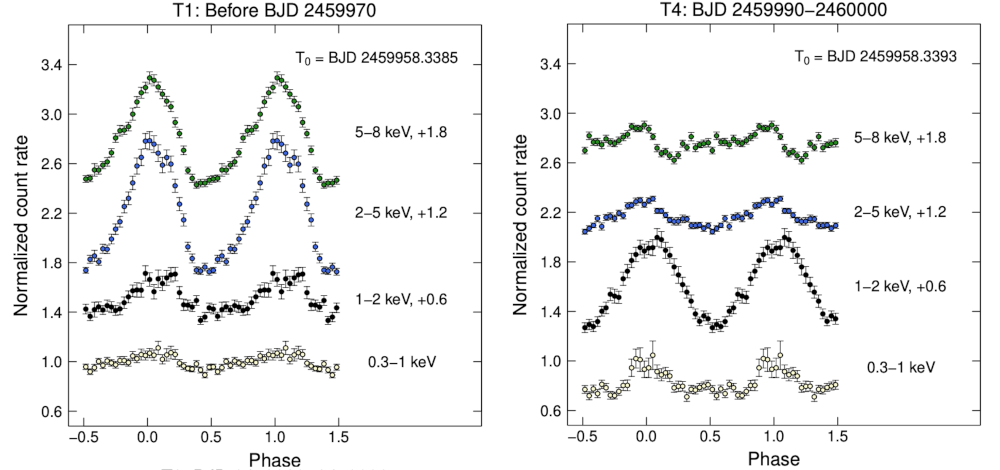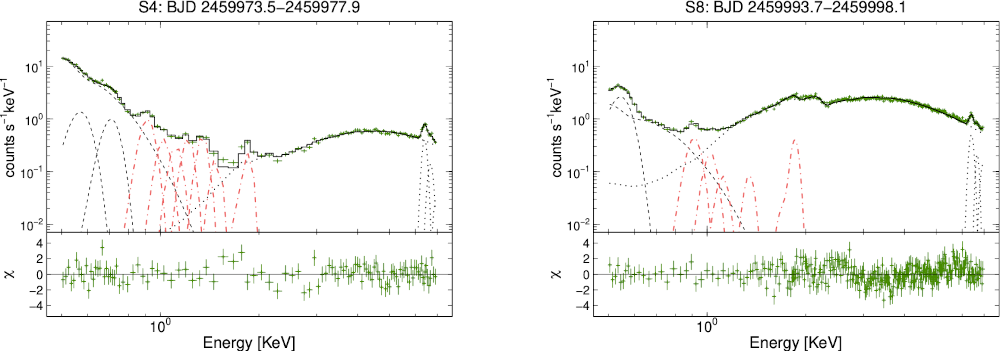NICER / ISS Science Nugget
for April 24, 2025
A sweeping curtain
NICER observations over more than 40 days in early 2023 tracked an outburst of the binary system GK Persei. Consisting of a magnetized white dwarf (WD), with approximately the mass of our Sun, and a lower-mass companion star, GK Per goes into outburst approximately once every three years when instabilities drive transfer of matter from the companion onto the WD. The flow forms a thin accretion disk, the inner edge of which is channeled by the WD's magnetic field onto its surface. Collisions within the free-falling gas super-heat it to a plasma, which in turn produces hot spots on the stellar surface at the magnetic poles. Both this "accretion column" and the hot spots produce copious X-rays. Some of this emission illuminates the inner regions of the accretion disk, stimulating the production of additional X-rays from fluorescing atoms there. A peer-reviewed manuscript by M. Kimura (Kanazawa Univ., Japan) and collaborators, accepted this week for publication in The Astrophysical Journal, demonstrates that these three regions can be distinguished by the energies and the time-variations of the X-rays they produce.
Across much of the X-ray band, pulsations from GK Per are seen with a period of 351.2 seconds, but with different dominant photon energies across the outburst. The period is believed to represent the rotation rate of the WD, but with a twist. In other hot-spot scenarios (for neutron stars and other types of WD systems), pulsations are thought to be a lighthouse-like sweeping of surface hot spots into and out of our line of sight, but in GK Per-like systems known as "intermediate polars" another mechanism is suggested by the evolving pulse spectroscopy. At the interface of the accretion column, defined by the star's magnetic field lines, and the inner edge of the accretion disk, likely puffed up by irradiation, is a structure appropriately called an accretion "curtain," which is swept around by the spinning WD. At certain phases of its rotation, the X-ray-bright accretion column is visible to us, while at others it is shrouded by the curtain. This absorption effect is evident in the loss of low-energy X-rays at certain pulse phases, and also the long-term evolution of the X-ray colors: near the peak of the outburst, when the mass transfer rate is high, the inner edge of the accretion disk moves closer to the WD, and it moves away near the end of the outburst when the mass transfer rate is low. The changing distance and geometry of the curtain relative to the hot plasma in the accretion column leaves its imprint on the combined timing-spectral properties of the X-ray emission.
The team also conducted strictly simultaneous - with NICER - visible-light observations using the ground-based Kiso 1.05 meter telescope and a high-speed camera, to search for correlated X-ray/optical variability; they found none, suggesting that the optical emission originates outside the curtain, likely in the accretion disk. Future outbursts observed with a similar multi-wavelength complement of instruments and well-sampled in time should confirm and extend these findings.


Top: The X-ray pulses of GK Persei evolving in outburst, as measured with NICER between approximately January 15-25 (left) and February 14-24 (right), 2023 ("BJD" is Barycentered Julian Day). For the pulse period of 351.2 seconds, 1.5 cycles are plotted and pulse shapes in different photon energy bands are artificially offset vertically for clarity. In the earlier interval, the pulses are better defined at higher energies (2 through 8 keV), whereas at later times they are more clearly distinguished at lower energies (1-2 keV). (Credit: Kimura et al. 2025)
Bottom: X-ray spectra of GK Per averaged over five-day intervals, 28 January to 2 February (left) and 17-22 February (right). In each panel, green crosses show NICER data, black steps represent a best-fit total model made up of several components: emission lines of neon, iron, magnesium, and silicon atoms (red dot-dash traces), a hot plasma including ionized iron (black dotted), and a thermal "blackbody" from the white-dwarf surface, together with oxygen and ionized iron (black dashed). At later times, the surface blackbody emission declines dramatically while the hot plasma becomes more prominent. (Credit: Kimura et al. 2025)
<< Previous
Main Index